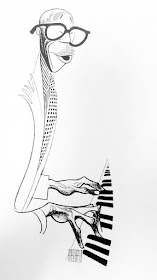Even before I became massively addicted to the theater--i.e. pre-Y2K--I became aware and fond of the legendary theatrical caricaturist, Al Hirschfeld.
I don't even quite remember how, for although Hirschfeld was most noted for augmenting Broadway reviews and features in the New York Times Arts section--though he also drew movie stars, musicians, politicians and much else--I didn't regularly read the Times.
I think I may have first encountered Hirschfeld's work, at least knowingly and en masse, in an exhibition somewhere in Chicago.
While I was certainly taken with his unique and whimsical portraits, I was also fascinated by learning of his trademark of hiding "NINA"--the name of his daughter--in most of his drawings, often repeatedly.
It was also cool to note that although I didn't come to know of him until he was in his 90s, Al Hirschfeld remained quite professionally active after I became aware--pretty much up until his death at in January 2003 at age 99-1/2.
I bought a sizable compendium of his work--Hirschfeld On Line--loved perusing it and hunting the NINAs, and watched the terrific 1996 documentary, The Line King: The Al Hirschfeld Story, which you can probably find at your local library.
 |
| Al Hirschfeld, Self-Portrait at 99. |
Recently, I became aware of the release of The Hirschfeld Century: Portrait of an Artist and His Age, a 2015 book edited and with text by David Leopold.
Although likely somewhat duplicative of Hirschfeld On Line, the Alfred A. Knopf publication seemed worth acquiring for under $20 on Amazon.
And it's pretty damn cool.
Admittedly, so far I've spent more time looking at the pictures than reading the text, but it's great to have the full swath of Hirschfeld's long career--including early movie posters promoting the likes of Charlie Chaplin and Laurel & Hardy and then through Al's 75 years with the New York Times, which essentially serves as a history of the American theater--accompanied by biographical information.
Certainly, Al Hirschfeld's illustrative insights on the personas of actors/characters and mirthful depictions of shows transcending generations are much more substantive than the NINA gimmick--which he was somewhat reluctantly compelled to continue beyond an initial salute to his daughter's birth due to public demand--but I valued author Leopold's illuminations, such as:
"Searching for "NINA' took on a life of its own as the Pentagon asked permission to use his drawings in the mid-sixties to train pilots to pinpoint targets. Later, a University of Pennsylvania medical researcher used Al's drawings to train doctors to read X-rays more carefully when looking, for instance, for breast cancer tumors. The U.S. Postal Service asked, on orders from the postmaster general, that he include "NINAs" in his stamp designs, overruling its own regulations against hidden messages. "It wouldn't be a Hirschfeld without a NINA," said the official."
I also valued the new book for its inclusion of Hirschfeld art that goes beyond his typical theater and pop culture caricatures, including several color lithographs from a Kabuki series inspired by a visit to Japan.
Below I will include some of my favorite pieces included in the new tome, while reiterating that all artwork is © The Al Hirschfeld Foundation. You can see much more at AlHirschfeldFoundation.org as well as on AlHirschfeld.com, run by the artist's longtime exclusive dealer, Margo Feiden. (I'll also note that my recent post on My 100 Favorite Artists of Popular Music included an image at top comprising several Hirschfeld rock 'n roll portraits.)
I apologize if the resolution on some of the images below don't allow you to search for NINAs; you can click on them to enlarge somewhat, but may want to seek NINA elsewhere--online and whenever you come across a Hirschfeld drawing.
 | |
| Another Fine Mess, 1930. Hirschfeld's posters for the first eight Laurel & Hardy films helped establish their personas with the public. Too early a piece for any NINAs to be included. |
 | |
| The Sound of Music (movie). Julie Andrews and Christopher Plummer, 1965. 4 NINAs indicated in the signature subscript; I see at least a couple in the children's sleeves. |
 |
| Peter Pan. Mary Martin, Cyril Ritchard, Richard Wyatt and Don Lurio, 1954. No NINA subscript indicator, but I found at least two. |
 |
| The Beatles v. Sister Sourire, the Singing Nun, 1964. No NINA indicator, but I see at least one prominently. |
 |
| Aerosmith, 1977. Used on the Draw the Line album cover. 3 NINAs indicated; the hair is always a good place to start searching. |
 |
| Frank Langella as Dracula, 1977. No NINA indicator, but I see 2, maybe 3. |
 |
| Elvis Presley, 1968. 5 NINAs indicated; all should be findable even at this resolution. |
 |
| Eubie Blake, 1978. No NINA indicator, but a nifty one should be quite apparent. |
 |
| Shibaraku, from the Kabuki series, lithograph, 1976. No NINA indicator and I don't see any. |
 |
| The Movies, 1954. Good luck finding any NINAs; no indicator number. |
 |
| The Owl and the Pussycat. George Segal and Barbra Streisand, 1970. 7 NINAs indicated. I see a few; all may be rather tiny. |




No comments:
Post a Comment